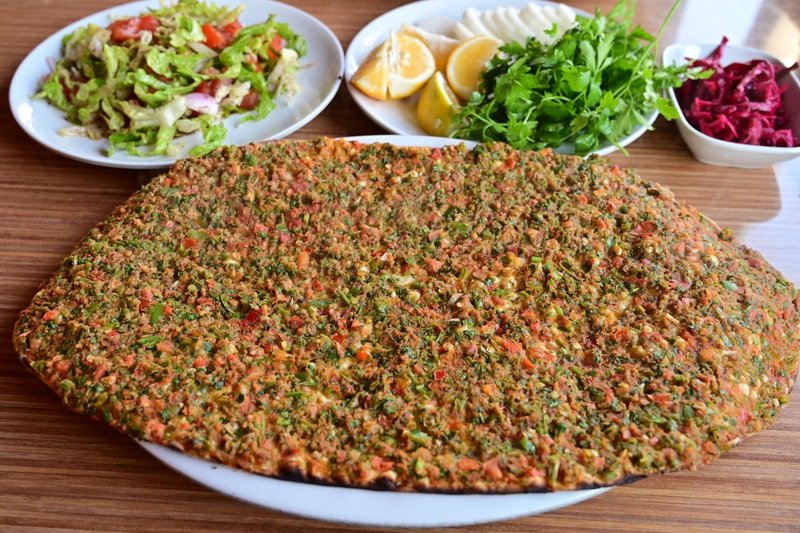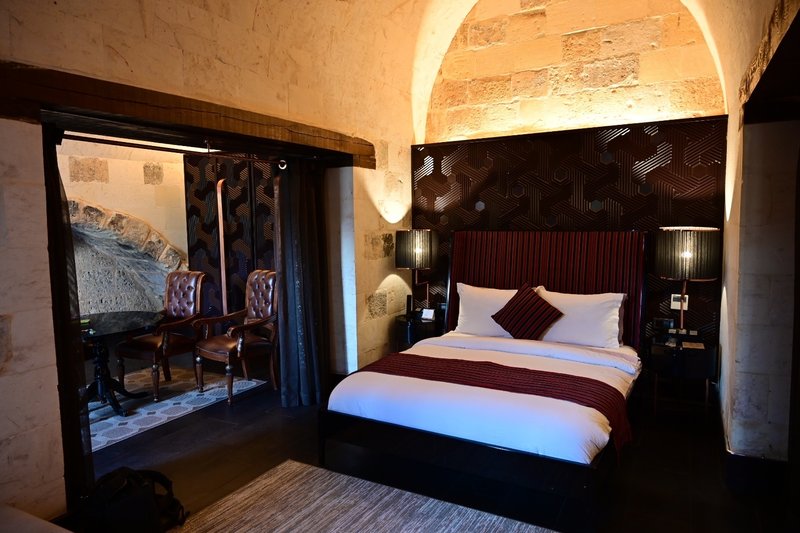
ガズィアンテプ1:ベイランはトルコのユッケジャンクッパ?
2021年末に訪れたトルコ南東アナトリア地方の街ガズィアンテプの食い倒れ紀行を始めます。
トルコ南東部は2023年2月6日に起きたトルコ・シリア大地震で大きな被害を受け、一年以上経つ今も被害の全容が掴めていません。一刻も早い復興を願っています。
English follows Japanese.
南東アナトリア地方の料理とは?
2021年12月25日、日本でコロナウィルス・オミクロン株が大流行し始めた矢先、僕はトルコ共和国、南東アナトリア地方の町ガズィアンテプに到着した。前回のトルコ出張はコロナ禍が始まる前年の2019年7月だったので、約2年半ぶりだった。
僕は1990年にトルコを初めて訪れ、トルコ料理の美味しさを知り、以来30年以上、トルコに通い料理を探求し続けてきた。そしてトルコの7つの地理区分のうちの4つ、イスタンブルを含むマルマラ海沿岸地方、中央アナトリア地方、地中海沿岸地方、エーゲ海沿岸地方を料理取材のために訪れ、自分なりに咀嚼して、これまでの本に書き綴ってきた。すると残るは黒海沿岸地方と東アナトリア地方、そして南東アナトリア地方だった。

南東アナトリア地方は文字通りトルコの南東部に位置し、南にはシリアとイラクと国境を接している。東側には地中海地方最南端のハタイ県を挟んで地中海が位置する。アナトリア半島とメソポタミアをつなぐ場所のため、中世には十字軍とアラブが交戦し、オスマン帝国時代にはアラブ、クルド、アルメニア、フランス、ユダヤ人など様々な人々が行き来した。そのため料理はアラブ料理と地中海料理からの影響が強い。
ただ、南東アナトリア地方の料理と言われても、多くの読者はピンと来ないだろう。実はイスタンブルでも、そして東京や世界中にあるトルコ料理店でも、この地方の料理を口にする機会はかなり多い。ここにその例を挙げてみよう。

メルジュメッキ・チョルバ レンズ豆のスープ
エゾゲリン・チョルバ スパイシーなレンズ豆のスープ
ウルファ・ケバブ 挽き肉を練り鉄串に貼り付けて炭火で焼いたケバブ
パトゥルジャン・ケバブ 挽き肉を練り、鉄串に輪切りの茄子と挟みこんで、炭火で焼いたケバブ
シシ・ケバブ 仔羊肉を鉄串に刺して炭火で焼いたケバブ
ラフマージュン 挽き肉とトマトやハーブのみじん切りを乗せた薄焼きピザ
チー・キョフテ 生肉とブルグル、トマトペースト、パプリカペーストを練った団子
イチリ・キョフテ 挽き肉とブルグル、トマトペースト、パプリカペーストの団子のフライ
クル・パトゥルジャン・ドルマ 乾燥茄子のご飯詰め
クル・ビベール・ドルマ 乾燥パプリカのご飯詰め
バクラヴァ フィロ生地を何重にも重ねピスタチオ粉を詰めて焼いたお菓子
カトメル 薄い生地の間にピスタチオ粉と砂糖とクロテッドクリームを挟んで焼いたクレープ

世界中どこのトルコ料理店でもメニューに掲げているシシ・ケバブやチョルバ、そして最近では東京のケバブ屋でも目にするラフマージュンも実は南東アナトリア地方から全国に広まった料理である。僕が毎回友人たちと夜中過ぎに訪れているアジア側カドゥキョイにある24時間営業のチョルバ&ケバブ屋や、高級住宅街エティレルにあるケバブが名物の老舗メイハネ(居酒屋)も南東アナトリア地方出身の家族が始めたお店と聞いていた。更に僕がこれまでに取材したシェフもこの地方や近隣地方出身の方が目立った。

ガズィアンテプを訪れずして、トルコ料理を語るわけにいかない!
南東アナトリア地方を訪れずして、トルコ料理を語るわけにいかない!
そう思い立ち、2年半ぶりのトルコ帰還に際し、行き先はユネスコ創造都市ネットワーク食文化部門に認定され、南東アナトリア地方における一番のグルメ都市として知られるガズィアンテプを選んだ。ちなみにトルコでは3つの都市がユネスコ創造都市ネットワーク食文化部門に認定されている。ガズィアンテプ、地中海地方のハタイ、エーゲ海地方内陸のアフィヨンカラヒサルである。残りの2つの街もいつか行かねばならぬ!

ターキッシュエアラインズで羽田から12時間のフライトでイスタンブルに着き、そこから国内線に乗り換え、更に一時間半でガズィアンテプ空港に到着。午前10時、空は晴れているが気温は摂氏5℃と、同じ時期の東京やイスタンブルと比べるとかなり寒い。夜はマイナス5℃以下まで下がるらしい。空港からはタクシーを拾い、15分で旧市街へ。予約した宿「HSVHN(ヒシュヴァハン)」は街の観光名所ガズィアンテプ城の目の前にあった。

HSVHNはトルコ語で「ハン」、ペルシャ語で「キャラバンサライ」と呼ばれる中世の隊商宿を近年になって全面改装したいわゆるブティックホテル。四方は石造りの堅牢な外壁に囲まれていて、馬がかろうじて通れるほどの狭い正門をくぐると、広大な中庭が広がっている。中庭にはレストラン用のソファテーブルと日除けのタープが無数に並んでいたが、ソファにはビニールシートがかけられ、その上には雪が残っていた。極寒の冬の間、野外席を使う人はいないのだろう。中庭の正面奥の外壁部分が人気の地元料理レストラン「HSVHN Lokanta」になっていて、左右の外壁部分がホテルの部屋になっている。

中庭の右手前側の外壁に沿った部屋に案内された。石のブロックを積み上げた壁は冬の冷気と真夏の熱気を遮断するためだろう。窓も小さく、中庭方向に付いているだけなので、まるでカッパドキアの洞窟ホテルにいるような気分になった。しかし、サロンとベッドルームのスイート形式の部屋は面積が50㎡近くあり、広く、改装されたばかりで内装も新しく、居心地は悪くない。季節が良ければ中庭や共用スペースも自分の部屋のように使えて、更に居心地は良いだろう。

ガズィアンテプ旧市街
荷物を下ろすと、長旅の後でお腹がそこそこ空いていた。夕飯はホテル内のレストラン「HSVHN Lokanta」でしっかり食べるとして、ランチを兼ねた朝食に出ることにした。宿を出て、ガズィアンテプ城に沿って東に歩き、旧市街のメイン通り「ギュムリュック大通り」を右折し、南に向かって5分ほど歩く。大通りとは名付けられているが、基本的に自動車が入れない歩行者専用道路で、道の両側にはレストランやお菓子屋や食料品店がひしめくように並んでいた。ベージュ色の石造りの建物と、その店頭に並ぶ赤いパプリカ、紫の茄子、黄色のスパイス、緑のピスタチオなどの色が鮮やかで、もしトルコの国旗が目に入らなかったら、シリアやレバノンのメディナ(旧市街)に迷い込んでしまったかのようだ。

大通りから右へ細い下り坂を降りると、「トンテンカン、トンテンカン」と金属を叩く音が前後左右から聞こえてきた。銅細工専門のスークに出た。狭い通りに木造の古い造りのお店が並び、店頭にはきらびやかな銅細工のお盆やお皿、ターキッシュコーヒー用のカップなどが所狭しと並べられている。ここでは数百年間、時が止まっているように思える。

朝食スープ「ベイラン」の銘店Metanet Lokantasıへ
1635年頃創業されたとされるトルコ最古のカフェ「Tahmis Kahvesi(タフミシュ・カフヴェスィ)」の前を過ぎ、道なりに東に進むと、お目当ての店「Metanet Lokantası(メタネト・ロカンタス」に到着した。

ここはガズィアンテプ名物料理「ベイラン」が人気のお店。ベイランは仔羊肉を長時間かけてトロトロに煮込み、ほぐしたものとご飯、赤唐辛子粉が具材の羊出汁のスープだ。主に朝食とされ、イスタンブルでもスープ専門店や南東アナトリア地方料理専門店で食べられるが、僕はこれまで目にしたことがなかった。

注文すると、厨房のアニキが銀メッキされた銅細工のスープ皿に、ほぐした仔羊肉、白いご飯、たっぷりの赤唐辛子粉を盛り、それをスープ皿を横に4つ並べられる専用のガスコンロに置き、ボワーとガスの火を付ける。普通の強火ではなく、ゴーっと音が立ち、炎が20cmくらい上まで上がるほどの超強火である。そこにお玉で羊出汁のスープを注ぎ入れ、チャチャっとかき回すと、スープの脂分に火がつき、炎がボワっと高く燃え上がる。そして、羊の焦げたなんとも良い香りが漂い始める。スープを数回注ぎ入れ、余分な脂を飛ばした後、銅製のお盆に置き、お客にサーブする。ガスコンロが厨房の奥ではなく、あえてお客から見える場所に設置されているのは、ベイランにはこの一連のプレゼンテーション、いやセレモニーが重要なのだろう。

お皿まで熱されて、オレンジ色のスープが泡立っているところに、レモンを絞っていただく。スプーンですくったスープを不用意に口に入れると当然口の中は大火傷してしまうが、これは美味い! 美味すぎる! 羊出汁のスープに赤唐辛子粉とレモン汁、なんという濃厚かつ爽やかな汁物だ。しかも、日本人が大好きな白米が味の逃げ場になってくれている。これはトルコのお茶漬け? いや、ユッケジャンクッパのほうがもっと近いか?! 朝食からこんなに美味いスープを食べられるなんて、やっぱりトルコのスープ文化最高! 明日もほかの店でベイランを頼もうっと。

トルコの南東アナトリア地方、ガズィアンテプ食い倒れ旅は幸先の良いスタートを切った。
Gaziantep 1: Is Beyran Turkish Yukgaejang Gukbap?
South Eastern Anatolian Cuisine?
On December 25, 2021, just as the Omicron variant of the coronavirus began to surge in Japan, I arrived in the town of Gaziantep in the Southeastern Anatolia region of the Republic of Turkey. My last business trip to Turkey was in July 2019, just before the pandemic began, so it had been about two and a half years.
I first visited Turkey in 1990, discovered the deliciousness of Turkish cuisine, and have since continued to visit and explore Turkish food for over 30 years. I have visited four of Turkey's seven geographical regions for culinary research, including the Marmara region around Istanbul, Central Anatolia, the Mediterranean region, and the Aegean region. I have digested these experiences and written about them in my books. This left only the Black Sea region, Eastern Anatolia, and Southeastern Anatolia unexplored.
Southeastern Anatolia is located in the southeastern part of Turkey, bordering Syria and Iraq to the south. To the east, it is flanked by the Mediterranean's southernmost Hatay province. This region connects the Anatolian Peninsula and Mesopotamia, making it a historical battleground during the Crusades and a melting pot of Arab, Kurdish, Armenian, French, and Jewish cultures during the Ottoman era. Consequently, its cuisine is heavily influenced by Arab and Mediterranean cooking.
However, when one mentions Southeastern Anatolia's cuisine, many readers might not immediately recognize it. In fact, both in Istanbul and Turkish restaurants around the world, there are many opportunities to taste dishes from this region. Here are some examples:
Mercimek Çorbası: Lentil soup
Ezogelin Çorbası: Spicy lentil soup
Urfa Kebab: Minced meat kebab grilled on iron skewers
Patlıcan Kebabı: Minced meat and eggplant slices grilled on skewers
Şiş Kebabı: Grilled lamb skewers
Lahmacun: Thin crust pizza with minced meat, tomatoes, and herbs
Çiğ Köfte: Raw meatballs with bulgur, tomato paste, and pepper paste
İçli Köfte: Fried meatballs with bulgur, tomato paste, and pepper paste
Kuru Patlıcan Dolması: Stuffed dried eggplants
Kuru Biber Dolması: Stuffed dried peppers
Baklava: Pastry layered with pistachios and syrup
Katmer: Crepe-like pastry filled with pistachios, sugar, and clotted cream
Dishes like şiş kebab and çorba, found on the menus of Turkish restaurants worldwide, and lahmacun, now appearing even in Tokyo's kebab shops, all originated from Southeastern Anatolia and spread throughout the country. I’ve learned that the 24-hour çorba & kebab house in Kadıköy on the Asian side of Istanbul, which I visit late at night with friends, and the famous meyhane (tavern) in the upscale Etiler district, are run by families from Southeastern Anatolia. Additionally, many chefs I have interviewed are from this region or nearby areas.
No Antep Food, No Turkish Food!
No Southeastern Anatolian food, No Turkish Food !
With this thought in mind, I chose Gaziantep, recognized by UNESCO as a Creative City of Gastronomy and known as the top gourmet city in Southeastern Anatolia, for my return to Turkey after two and a half years. Incidentally, Turkey has three cities recognized by UNESCO as Creative Cities of Gastronomy: Gaziantep, Hatay in the Mediterranean region, and Afyonkarahisar in the Aegean region. I must visit the remaining two cities someday!
After a 12-hour flight from Haneda on Turkish Airlines, I arrived in Istanbul and then took a domestic flight, arriving at Gaziantep Airport in an hour and a half. It was 10 AM, the sky was clear, but at 5°C, it was much colder than Tokyo or Istanbul at the same time of year. The temperature reportedly drops below -5°C at night. I took a taxi from the airport and reached the old city in 15 minutes. My booked accommodation, "HSVHN (Hisvah Han)", was right in front of the famous Gaziantep Castle.
HSVHN is a so-called boutique hotel that recently fully renovated a medieval caravanserai called "Han" in Turkish and "Caravanserai" in Persian. The solid stone outer walls surrounded the premises, and upon passing through the narrow main gate, wide enough for just a horse, a vast courtyard opened up. Numerous sofa tables and sunshades lined the courtyard, though the sofas were covered in plastic sheets with snow on top, indicating no one used the outdoor seats in the freezing winter. The popular local cuisine restaurant "HSVHN Lokanta" was located at the far end of the courtyard, with the hotel rooms lining the side walls.
I was guided to a room along the right front side of the courtyard. The stone block walls likely provided insulation against the winter cold and the summer heat. The small window faced the courtyard, giving the room a cave-like feel akin to a hotel in Cappadocia. However, the suite, consisting of a living room and bedroom, was nearly 50 square meters, newly renovated, and comfortable. In good weather, the courtyard and common areas would feel like an extension of one’s room, enhancing the comfort.
Old Downtown of Gaziantep
After unpacking, I felt reasonably hungry after the long journey. Planning to have a proper dinner at the hotel’s restaurant "HSVHN Lokanta", I decided to go out for a brunch. Exiting the hotel, I walked east along Gaziantep Castle, turned right on the main street of the old city "Gümrük Avenue", and walked south for about five minutes. Despite being called an avenue, it was essentially a pedestrian-only street, crowded with restaurants, confectioneries, and grocery stores on both sides. The beige stone buildings and the vibrant colors of red paprika, purple eggplant, yellow spices, and green pistachios at the storefronts created a scene that, without the Turkish flags, might be mistaken for the medinas (old cities) of Syria or Lebanon.
Turning right from the avenue down a narrow slope, the sound of metal being struck echoed around me. I had arrived at the copperware market. The narrow street was lined with old wooden shops, with their dazzling copper trays, plates, and Turkish coffee cups displayed outside, making it seem as if time had stopped for hundreds of years.
Beyran at legendary Metanet Lokantası
Passing in front of "Tahmis Kahvesi", Turkey's oldest café founded around 1635, and continuing east, I reached my destination, "Metanet Lokantası". This restaurant is famous for Gaziantep’s specialty, "Beyran". Beyran is a soup made with long-simmered lamb meat, shredded and combined with rice and red chili powder in a lamb broth. Though available in Istanbul at soup specialty shops and Southeastern Anatolian cuisine restaurants, I had never encountered it before.
Upon ordering, the cook in the kitchen filled a silver-plated copper soup bowl with shredded lamb, white rice, and plenty of red chili powder. The bowl was then placed on a special gas stove, which could hold four soup bowls side by side. Unlike normal high heat, this stove roared, with flames shooting up to 20 cm. Lamb broth was ladled in, and the mixture was stirred, causing the soup's fat to ignite and flames to flare up. The aroma of charred lamb filled the air. After pouring the broth in several times and burning off excess fat, the soup was placed on a copper tray and served to the customer. The gas stove was deliberately placed where customers could see it, highlighting that the presentation, or rather the ceremony, is a crucial part of Beyran.
The bowl was heated, and the orange soup bubbled. Squeezing lemon into it, I took a spoonful, being careful not to burn my mouth, and it was delicious! Absolutely delicious! The lamb broth, red chili powder, and lemon juice combined to make a rich yet refreshing soup. Plus, the white rice beloved by Japanese served as a flavor escape. Is this Turkey’s tea rice? No, it’s more like Yukgaejang Gukbap! To be able to eat such delicious soup for breakfast, Turkish soup culture is the best! I’ll have Beyran at another restaurant tomorrow.
My gastronomic journey in Gaziantep, Southeastern Anatolia, Turkey, had a promising start.
この記事が気に入ったらサポートをしてみませんか?
